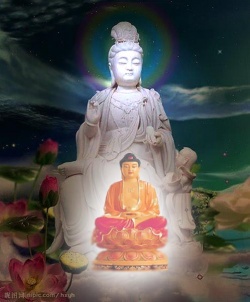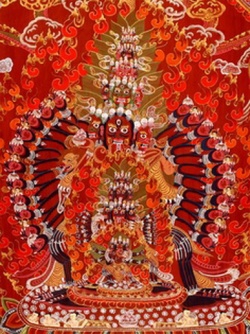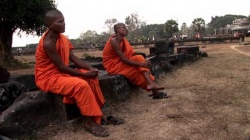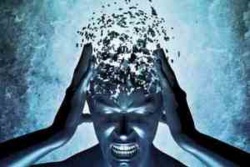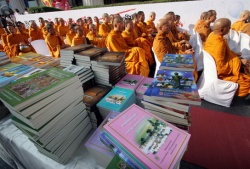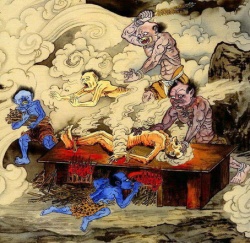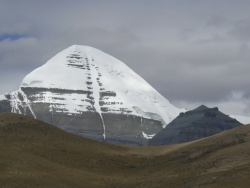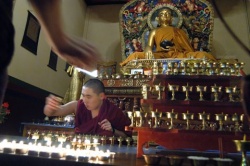Difference between revisions of "Correlating Yoga to the Stages"
(Created page with " <poem> Correlating Yoga to the Stages One way of viewing tantric Buddhism or Vajrayana is to see the various practices as organized into four categories or 4 c...") |
|||
| Line 1: | Line 1: | ||
| − | + | <nomobile>{{DisplayImages|4019|1776|3922|2515|632|2297|4528|739|758|3241}}</nomobile> | |
<poem> | <poem> | ||
| Line 6: | Line 6: | ||
One way of viewing [[tantric Buddhism]] or [[Vajrayana]] is to see the various practices as organized into four categories or 4 classes of [[yoga]]. These kinds of practices are considered to correspond to 10 steps on the road to [[enlightenment]] called, in [[Sanskrit]], [[bhumis]]. | One way of viewing [[tantric Buddhism]] or [[Vajrayana]] is to see the various practices as organized into four categories or 4 classes of [[yoga]]. These kinds of practices are considered to correspond to 10 steps on the road to [[enlightenment]] called, in [[Sanskrit]], [[bhumis]]. | ||
| − | Various schools do this in slightly different ways. For instance, [[Khenpo Karthar Rinpoche]] describes two such systems in his commentary on | + | Various schools do this in slightly different ways. For instance, [[Khenpo Karthar Rinpoche]] describes two such systems in his commentary on [[Ngeton Gyamtso]], the [[9th Karmapa's]] Ocean of Certainty. This is discussed by [[Thrangu Rinpoche]] as the [[Ocean of Definitive Meaning]]. |
| + | |||
The [[Dagpo Kagyu]] [[tradition]] matches [[Mahamudra]] in [[5 Paths]] to the 10 [[bhumis]]. In that system, the [[5 Paths]] are that of: | The [[Dagpo Kagyu]] [[tradition]] matches [[Mahamudra]] in [[5 Paths]] to the 10 [[bhumis]]. In that system, the [[5 Paths]] are that of: | ||
| + | |||
1. [[Accumulation]] | 1. [[Accumulation]] | ||
| Line 15: | Line 17: | ||
4. [[Meditation]] | 4. [[Meditation]] | ||
5. No-More-Meditation | 5. No-More-Meditation | ||
| + | |||
The [[objective]], or [[Buddhahood]], is considered to have been achieved at the end of the No-More-Meditation stage. | The [[objective]], or [[Buddhahood]], is considered to have been achieved at the end of the No-More-Meditation stage. | ||
| − | A beginner is said to be "Entering the Stream." Most practitioners are working at the [[Accumulation]] or rarely, the Juncture stage. Those who have generated [[bodhicitta]] as an [[aspiration]] may even have undertaken it in [[action]], but chances are, are still pre-bhumi. The [[Bhumi]] of the [[Joyous]] is reached only when we have gotten a direct (i.e., not merely by means of {{Wiki|intellect}}, [[logic]] or {{Wiki|inference}}) glimpse of [[shunyata]] ([[Emptiness]].) | + | A beginner is said to be "Entering the Stream." Most practitioners are working at the [[Accumulation]] or rarely, the Juncture stage. Those who have generated [[bodhicitta]] as an [[aspiration]] may even have undertaken it in [[action]], but chances are, are still pre-[[bhumi]]. |
| + | |||
| + | The [[Bhumi]] of the [[Joyous]] is reached only when we have gotten a direct (i.e., not merely by means of {{Wiki|intellect}}, [[logic]] or {{Wiki|inference}}) glimpse of [[shunyata]] ([[Emptiness]].) | ||
| + | |||
| + | |||
| + | Each [[path]] is further subdivided into smaller or shorter stages. For example, the [[Path]] of Juncture comprises stages called Heat, Peak, [[Forbearance]] and Supreme [[Mundane]] [[Dharma]]. | ||
| − | + | There are definite criteria that indicate the student's [[accomplishment]] on, or of, the way. | |
~~~~~~~~~~~~~~~~~~~~~~~~~~~~~~~~~~~~~~~~~~~~~~~~~~~~ | ~~~~~~~~~~~~~~~~~~~~~~~~~~~~~~~~~~~~~~~~~~~~~~~~~~~~ | ||
| + | |||
HH [[Drikung Kyabgon]], in The Practice of [[Mahamudra]], responds to a question concerning the [[relation]] of these stages to the [[bodhisattva's]] levels of [[realization]]: | HH [[Drikung Kyabgon]], in The Practice of [[Mahamudra]], responds to a question concerning the [[relation]] of these stages to the [[bodhisattva's]] levels of [[realization]]: | ||
| Line 28: | Line 37: | ||
"These are somewhat different ways of looking at the same process. | "These are somewhat different ways of looking at the same process. | ||
First of all, the fivefold [[Mahamudra]] does not relate directly to the ten | First of all, the fivefold [[Mahamudra]] does not relate directly to the ten | ||
| − | [[bodhisattva bhumis]]. There is no need to look for that. [[Mahamudra]] is really talking about something a bit different, it's approaching it from the point of view of practice. What relates more closely to the [[bodhisattva bhumis]] is what was just discussed -- the four levels of [[yogic]] [[attainment]]. These do relate more directly to the ten [[bodhisattva bhumis]], and, in fact, one [[great teacher]] of the [[Drukpa Kagyu]] wrote a text which includes a [[discussion]] relating those two systems. | + | [[bodhisattva bhumis]]. |
| + | |||
| + | There is no need to look for that. [[Mahamudra]] is really talking about something a bit different, it's approaching it from the point of view of practice. What relates more closely to the [[bodhisattva bhumis]] is what was just discussed -- the four levels of [[yogic]] [[attainment]]. | ||
| + | |||
| + | These do relate more directly to the ten [[bodhisattva bhumis]], and, in fact, one [[great teacher]] of the [[Drukpa Kagyu]] wrote a text which includes a [[discussion]] relating those two systems. | ||
| + | |||
Without going into a great amount of detail, we could say that the first level of [[yogic]] [[attainment]], that of [[one-pointed concentration]], wherein the [[direct realization]] of the [[nature of mind]] first begins to dawn, corresponds to the first [[bodhisattva bhumi]] where [[ultimate reality]] is first glimpsed. However, you have the three levels of that first stage of [[yogic]] [[realization]], that of the lesser, the middle, and greater [[practitioner]]. | Without going into a great amount of detail, we could say that the first level of [[yogic]] [[attainment]], that of [[one-pointed concentration]], wherein the [[direct realization]] of the [[nature of mind]] first begins to dawn, corresponds to the first [[bodhisattva bhumi]] where [[ultimate reality]] is first glimpsed. However, you have the three levels of that first stage of [[yogic]] [[realization]], that of the lesser, the middle, and greater [[practitioner]]. | ||
| − | |||
| − | + | Technically, the first [[bodhisattva bhumi]] would correspond only to the level of the [[highest]] [[practitioner]] of the first level of [[yogic]] [[realization]]. Only at that level is [[reality]] actually glimpsed. | |
| − | From there you can go up through the [[bhumis]], starting with the lowest level of practice of the second stage of [[realization]], that of freedom from projection; this would be the second [[bodhisattva bhumi]]. The middle level of practice at that [[state]] would be the third, and the [[highest]] level of practice at that stage is the fourth. Then, the three stages of [[yogic]] [[realization]] of one {{Wiki|taste}} correspond to the fifth, sixth, and seventh. Then finally, the three levels of practice at the [[highest]] level of [[realization]] correspond to the last three, the eighth, ninth, and tenth [[bodhisattva bhumis]]. Once one has [[attained]] the eighth [[bodhisattva bhumi]], this is considered to be the [[enlightenment]] of the [[Buddha]], but it has to be filled out in the ninth and finally, in the tenth stage." | + | So the lesser and the middle level [[practitioner]] of the first stage of [[yogic]] [[realization]] would correspond to the [[Path of Preparation]] levels called "heat" and the level called "summit," respectively. |
| + | |||
| + | These are the second to the [[highest]] and the [[highest]] levels of the [[Path of Preparation]]. This precedes the Dharshana-marga, the [[Path of Seeing]]. | ||
| + | |||
| + | The [[Path of Seeing]] is {{Wiki|distinguished}} by the first glimpse of [[ultimate reality]], the [[non-conceptual]] direct [[perception]] of [[emptiness]], which is what is gained on the first level of [[yogic]] [[realization]] by the [[highest]] level of [[practitioner]]. | ||
| + | |||
| + | So, what we have is the first of the [[bodhisattva bhumis]] corresponding to the [[highest]] level of practice of the first stage of [[yogic]] [[realization]]. | ||
| + | |||
| + | |||
| + | From there you can go up through the [[bhumis]], starting with the lowest level of practice of the second stage of [[realization]], that of freedom from projection; this would be the second [[bodhisattva bhumi]]. | ||
| + | |||
| + | The middle level of practice at that [[state]] would be the third, and the [[highest]] level of practice at that stage is the fourth. | ||
| + | |||
| + | Then, the three stages of [[yogic]] [[realization]] of one {{Wiki|taste}} correspond to the fifth, sixth, and seventh. | ||
| + | |||
| + | Then finally, the three levels of practice at the [[highest]] level of [[realization]] correspond to the last three, the eighth, ninth, and tenth [[bodhisattva bhumis]]. Once one has [[attained]] the eighth [[bodhisattva bhumi]], this is considered to be the [[enlightenment]] of the [[Buddha]], but it has to be filled out in the ninth and finally, in the tenth stage." | ||
| − | The | + | The [[10 Bhumis]]. |
A Review | A Review | ||
| − | The | + | The [[First Bhumi]], [[Joyous]], corresponds to the [[Path of Seeing]] and all the rest cover the [[Path of Meditation]], except for the final one, the [[Tenth Bhumi]] called [[Dharma Clouds]] which is the stage of No-More-Meditation. |
The Six common [[Paramitas]] are each related in sequence during the [[accomplishment]] of the first [[six bhumis]], and a further 4 less well-known are emphasized in the last 4 stages. | The Six common [[Paramitas]] are each related in sequence during the [[accomplishment]] of the first [[six bhumis]], and a further 4 less well-known are emphasized in the last 4 stages. | ||
| − | The [[Seventh bhumi]], Gone Afar, is an important milestone since at that juncture there is no way that a [[bodhisattva]] will fall back. The great [[mahasattvas]] [[Chenrezig]], [[Manjushri]] and [[Maitreya]] are believed to have [[attained]] this level. Some view the [[bhumis]] as "places," for [[Maitreya]] is said to be dwelling there while awaiting to [[manifest]] as the [[future Buddha]]. | + | The [[Seventh bhumi]], Gone Afar, is an important milestone since at that juncture there is no way that a [[bodhisattva]] will fall back. |
| + | |||
| + | The great [[mahasattvas]] [[Chenrezig]], [[Manjushri]] and [[Maitreya]] are believed to have [[attained]] this level. | ||
| + | |||
| + | Some view the [[bhumis]] as "places," for [[Maitreya]] is said to be dwelling there while awaiting to [[manifest]] as the [[future Buddha]]. | ||
| + | |||
| + | |||
[[Mahamudra]] | [[Mahamudra]] | ||
| − | |||
| − | The 4 [[Yogas]] of [[Mahamudra]] correspond to 4 stages that practitioners can pass through on the way to "[[Fruition]]" or the [[ultimate attainment]] which is [[Buddhahood]]. They are: | + | The 4 [[Yogas]] of [[Mahamudra]] correspond to 4 stages that practitioners can pass through on the way to "[[Fruition]]" or the [[ultimate attainment]] which is [[Buddhahood]]. |
| + | |||
| + | They are: | ||
1. [[One-Pointedness]] | 1. [[One-Pointedness]] | ||
| Line 59: | Line 94: | ||
3. One-Taste | 3. One-Taste | ||
4. Non-Meditation | 4. Non-Meditation | ||
| + | |||
These have been further divided into lesser, {{Wiki|medium}} and greater by the [[masters]] of [[Mahamudra]] who use various criteria to evaluate the student's progress. | These have been further divided into lesser, {{Wiki|medium}} and greater by the [[masters]] of [[Mahamudra]] who use various criteria to evaluate the student's progress. | ||
| − | [[Dakpo Kagyu]]: [[Master]] Gotsangpa, a [[Drukpa]] founder, sees the stages as: | + | [[Dakpo Kagyu]]: [[Master]] [[Gotsangpa]], a [[Drukpa]] founder, sees the stages as: |
| − | Lesser [[One-Pointedness]]: [[Path of Accumulation]] (pre-bhumi) | + | Lesser [[One-Pointedness]]: [[Path of Accumulation]] (pre-[[bhumi]]) |
| − | {{Wiki|Medium}} [[One-Pointedness]]: Heat and Peak of Juncture (pre-bhumi) | + | {{Wiki|Medium}} [[One-Pointedness]]: Heat and Peak of Juncture (pre-[[bhumi]]) |
| − | Greater [[One-Pointedness]]: [[Forbearance]] and Supreme Juncture (still pre-bhumi) | + | Greater [[One-Pointedness]]: [[Forbearance]] and Supreme Juncture (still pre-[[bhumi]]) |
Lesser [[Simplicity]]: [[First bhumi]] | Lesser [[Simplicity]]: [[First bhumi]] | ||
| Line 74: | Line 110: | ||
Lesser One-Taste: [[Seventh bhumi]] | Lesser One-Taste: [[Seventh bhumi]] | ||
{{Wiki|Medium}} One-Taste: [[Eighth bhumi]] | {{Wiki|Medium}} One-Taste: [[Eighth bhumi]] | ||
| − | Greater One-Taste: | + | Greater One-Taste: [[Ninth bhumi]] (to immediate [[attainment]] of Tenth) |
Lesser Non-Meditation: [[Tenth bhumi]] | Lesser Non-Meditation: [[Tenth bhumi]] | ||
| Line 100: | Line 136: | ||
Greater Non-Meditation: [[Buddhahood]] | Greater Non-Meditation: [[Buddhahood]] | ||
| − | Tsele Natshok Rangdrol in [[Lamp | + | [[Tsele Natshok Rangdrol]] in [[Lamp of Mahamudra]] summarizes them as: |
Lesser [[Simplicity]]: First to Third [[Bhumis]] | Lesser [[Simplicity]]: First to Third [[Bhumis]] | ||
| Line 114: | Line 150: | ||
Greater Non-Meditation: [[Buddhahood]] | Greater Non-Meditation: [[Buddhahood]] | ||
| − | "It is important to understand that the qualities and [[attributes]] of these [[Paths]] and [[Bhumis]] and so on are for us to aspire to and be [[mindful]] of. To truly do that, it takes more than looking at charts like these, [we need to] really listen to the [[transmission]] of the [[Mahamudra | + | "It is important to understand that the qualities and [[attributes]] of these [[Paths]] and [[Bhumis]] and so on are for us to aspire to and be [[mindful]] of. To truly do that, it takes more than looking at charts like these, [we need to] really listen to the [[transmission]] of the [[Mahamudra masters]]." |
</poem> | </poem> | ||
| + | {{R}} | ||
| + | [http://www.khandro.net/Buddhism_maha_stages.htm] | ||
| + | [[Category:Bhūmi's]] | ||
Latest revision as of 15:32, 18 October 2015
Correlating Yoga to the Stages
One way of viewing tantric Buddhism or Vajrayana is to see the various practices as organized into four categories or 4 classes of yoga. These kinds of practices are considered to correspond to 10 steps on the road to enlightenment called, in Sanskrit, bhumis.
Various schools do this in slightly different ways. For instance, Khenpo Karthar Rinpoche describes two such systems in his commentary on Ngeton Gyamtso, the 9th Karmapa's Ocean of Certainty. This is discussed by Thrangu Rinpoche as the Ocean of Definitive Meaning.
The Dagpo Kagyu tradition matches Mahamudra in 5 Paths to the 10 bhumis. In that system, the 5 Paths are that of:
1. Accumulation
2. Juncture
3. Seeing
4. Meditation
5. No-More-Meditation
The objective, or Buddhahood, is considered to have been achieved at the end of the No-More-Meditation stage.
A beginner is said to be "Entering the Stream." Most practitioners are working at the Accumulation or rarely, the Juncture stage. Those who have generated bodhicitta as an aspiration may even have undertaken it in action, but chances are, are still pre-bhumi.
The Bhumi of the Joyous is reached only when we have gotten a direct (i.e., not merely by means of intellect, logic or inference) glimpse of shunyata (Emptiness.)
Each path is further subdivided into smaller or shorter stages. For example, the Path of Juncture comprises stages called Heat, Peak, Forbearance and Supreme Mundane Dharma.
There are definite criteria that indicate the student's accomplishment on, or of, the way.
~~~~~~~~~~~~~~~~~~~~~~~~~~~~~~~~~~~~~~~~~~~~~~~~~~~~
HH Drikung Kyabgon, in The Practice of Mahamudra, responds to a question concerning the relation of these stages to the bodhisattva's levels of realization:
"These are somewhat different ways of looking at the same process.
First of all, the fivefold Mahamudra does not relate directly to the ten
bodhisattva bhumis.
There is no need to look for that. Mahamudra is really talking about something a bit different, it's approaching it from the point of view of practice. What relates more closely to the bodhisattva bhumis is what was just discussed -- the four levels of yogic attainment.
These do relate more directly to the ten bodhisattva bhumis, and, in fact, one great teacher of the Drukpa Kagyu wrote a text which includes a discussion relating those two systems.
Without going into a great amount of detail, we could say that the first level of yogic attainment, that of one-pointed concentration, wherein the direct realization of the nature of mind first begins to dawn, corresponds to the first bodhisattva bhumi where ultimate reality is first glimpsed. However, you have the three levels of that first stage of yogic realization, that of the lesser, the middle, and greater practitioner.
Technically, the first bodhisattva bhumi would correspond only to the level of the highest practitioner of the first level of yogic realization. Only at that level is reality actually glimpsed.
So the lesser and the middle level practitioner of the first stage of yogic realization would correspond to the Path of Preparation levels called "heat" and the level called "summit," respectively.
These are the second to the highest and the highest levels of the Path of Preparation. This precedes the Dharshana-marga, the Path of Seeing.
The Path of Seeing is distinguished by the first glimpse of ultimate reality, the non-conceptual direct perception of emptiness, which is what is gained on the first level of yogic realization by the highest level of practitioner.
So, what we have is the first of the bodhisattva bhumis corresponding to the highest level of practice of the first stage of yogic realization.
From there you can go up through the bhumis, starting with the lowest level of practice of the second stage of realization, that of freedom from projection; this would be the second bodhisattva bhumi.
The middle level of practice at that state would be the third, and the highest level of practice at that stage is the fourth.
Then, the three stages of yogic realization of one taste correspond to the fifth, sixth, and seventh.
Then finally, the three levels of practice at the highest level of realization correspond to the last three, the eighth, ninth, and tenth bodhisattva bhumis. Once one has attained the eighth bodhisattva bhumi, this is considered to be the enlightenment of the Buddha, but it has to be filled out in the ninth and finally, in the tenth stage."
The 10 Bhumis.
A Review
The First Bhumi, Joyous, corresponds to the Path of Seeing and all the rest cover the Path of Meditation, except for the final one, the Tenth Bhumi called Dharma Clouds which is the stage of No-More-Meditation.
The Six common Paramitas are each related in sequence during the accomplishment of the first six bhumis, and a further 4 less well-known are emphasized in the last 4 stages.
The Seventh bhumi, Gone Afar, is an important milestone since at that juncture there is no way that a bodhisattva will fall back.
The great mahasattvas Chenrezig, Manjushri and Maitreya are believed to have attained this level.
Some view the bhumis as "places," for Maitreya is said to be dwelling there while awaiting to manifest as the future Buddha.
Mahamudra
The 4 Yogas of Mahamudra correspond to 4 stages that practitioners can pass through on the way to "Fruition" or the ultimate attainment which is Buddhahood.
They are:
1. One-Pointedness
2. Simplicity
3. One-Taste
4. Non-Meditation
These have been further divided into lesser, medium and greater by the masters of Mahamudra who use various criteria to evaluate the student's progress.
Dakpo Kagyu: Master Gotsangpa, a Drukpa founder, sees the stages as:
Lesser One-Pointedness: Path of Accumulation (pre-bhumi)
Medium One-Pointedness: Heat and Peak of Juncture (pre-bhumi)
Greater One-Pointedness: Forbearance and Supreme Juncture (still pre-bhumi)
Lesser Simplicity: First bhumi
Medium Simplicity: Second through Fifth
Greater Simplicity: Sixth bhumi
Lesser One-Taste: Seventh bhumi
Medium One-Taste: Eighth bhumi
Greater One-Taste: Ninth bhumi (to immediate attainment of Tenth)
Lesser Non-Meditation: Tenth bhumi
Medium Non-Meditation: End of Tenth
Greater Non-Meditation: Buddhahood
Karma Kagyu:
The Ninth Gyalwa Karmapa Wangchuk Dorje, having surveyed Gotsangpa's scheme and many others, presents:
Lesser One-Pointedness: Path of Accumulation (pre-bhumi)
Medium One-Pointedness: Heat and Peak of Juncture (pre-bhumi)
Greater One-Pointedness: Forbearance & Supreme Juncture (still pre-bhumi)
Lesser Simplicity: First Bhumi
Medium Simplicity: Second through Fifth Bhumis
Greater Simplicity: Sixth Bhumi
Lesser One-Taste: Seventh Bhumi
Medium One-Taste: Eighth Bhumi
Greater One-Taste: Ninth Bhumi
Lesser Non-Meditation: Beginning of Tenth Bhumi
Medium Non-Meditation: End of Tenth Bhumi
Greater Non-Meditation: Buddhahood
Tsele Natshok Rangdrol in Lamp of Mahamudra summarizes them as:
Lesser Simplicity: First to Third Bhumis
Medium Simplicity: Fourth through Fifth Bhumis
Greater Simplicity: Sixth Bhumi
Lesser One-Taste: Seventh Bhumi
Medium One-Taste: Eighth Bhumi
Greater One-Taste: Ninth Bhumi
Lesser Non-Meditation: Beginning of Tenth Bhumi
Medium Non-Meditation: End of Tenth Bhumi
Greater Non-Meditation: Buddhahood
"It is important to understand that the qualities and attributes of these Paths and Bhumis and so on are for us to aspire to and be mindful of. To truly do that, it takes more than looking at charts like these, [we need to] really listen to the transmission of the Mahamudra masters."
